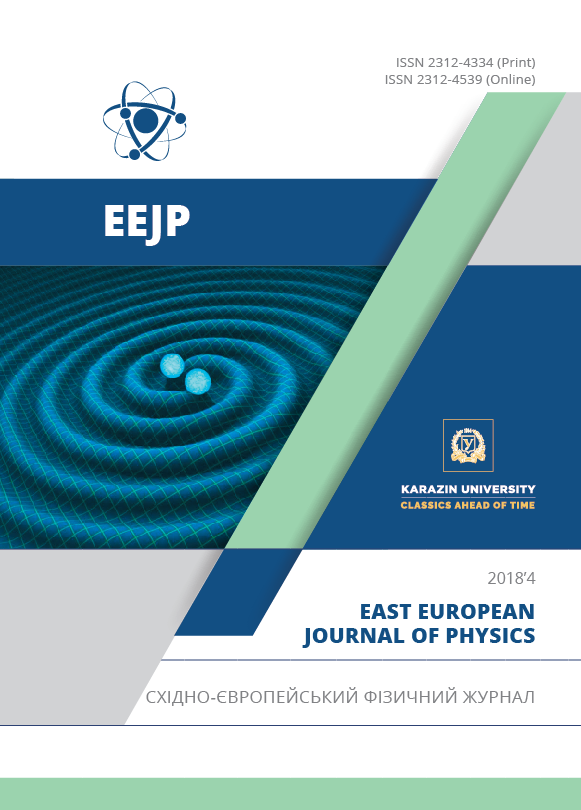Two band structure of poleskiy amber photoluminescence
Abstract
The paper presents the results of an experimental study of Poleskiy amber luminescence excited by narrow band UV radiation (7 nm) at the wavelength range of 310–410 nm with step of 10 nm. The purpose of the study was to determine the relation between an excitation of two luminescence centers, which we found earlier as a result of the mathematical treatment of the spectra obtained during a cycle of experiments on the photo- and X-ray luminescence of amber from the Poleskiy deposit. It was shown that for various samples the spectra of light excited by UV irradiation had a wide band of luminescence with some differences both in shapes and maximum positions. Increasing the exciting UV radiation wavelength, the monotonic displacement of the spectrum maximum position (from 2.62 to 2.5 eV) and the decrease of the full width at half maximum (from 0.92 to 0.62 eV) were observed. To analyze the spectra, we applied the mathematical treatment procedure that we successfully used earlier, namely fitting of experimental curves with Gaussian functions. It was demonstrated that the shape of our spectra could be with high accuracy deconvoluted by two peaks well described by Gaussian functions. The observed differences in shapes of the spectra can be explained by changes in the amplitudes of the two peaks with centers at 2.5 and 2.95 eV. The photoluminescence experiments with excitation by a narrow band UV radiation showed that light generation at wavelengths corresponding to these centers varied significantly by the change of primary UV radiation wavelength. The most intense excitation of the 2.5 eV band (496 nm) corresponds to the UV radiation wavelength of 384 nm (3.23 eV), and for the 2.95 eV band (420 nm) – 287.5 nm (4.32) eV. This led to the conclusion about an independent nature of the excitation of these centers. Spectrum changes can be explained by the different excitation efficiency of both centers.
Downloads
References
J. Zhao, G.B. McKenna, Polymer. 55, 2246–2253 (2014), doi: https://doi.org/10.1016/j.polymer.2014.03.004
R. Walstam, Acta Radiol. 37, 472–480 (1996), doi: https://doi.org/10.3109/02841859609177681
P.I. James, Patent US No. 8,088,267 B2.
V.V. Tsetlin, Yu.A. Akatov, V.V. Archangelsky, V.G. Mitrikas, V.A. Bondarenko and Teltsov M.V., Cosmic Research. 43, 314–318 (2005), doi: https://doi.org/10.1007/s10604-005-0051-3
Y.Q. Ye, H. Koshino, D. Hashizume, Y. Minamikawa, K.I. Kimura and S. Takahashi, Med. Chem. Lett. 22, 4259–4262 (2012), doi: https://doi.org/10.1016/j.bmcl.2012.05.022
M.A. Bogdasarov, Geol. Ore Depos. 49, 630–637 (2007), doi: https://doi.org/10.1134/S1075701507070215
J.S. Mills, R. White and L.J. Gough, Chem. Geol. 47, 15–39 (1984), doi: https://doi.org/10.1016/0009-2541(84)90097-4
N. Vávra, Ann. Des. Nat. Mus. Wien. 111A, 445–474 (2009), doi: https://www.jstor.org/stable/41701795
S. Pipatmanomai, C.A. Islas, I. Suelves, A.A. Herod, D.R. Dugwell and R. Kandiyoti, J. Anal. Appl. Pyrolysis. 58-59, 299–313 (2001), doi: https://doi.org/10.1016/S0165-2370(00)00167-4.
R.H. Brody, H.G.M. Edwards and A.M. Pollard, Using FT-Raman. 57, 1325–1338 (2001), doi: https://doi.org/10.1016/S1386-1425(01)00387-0
P. Vandenabeele, D.M. Grimaldi, H.G.M. Edwards and L. Moens, Spectrochim. Acta - Part A Mol. Biomol. Spectrosc. 59, 2221–2229 (2003), doi: https://doi.org/10.1016/S1386-1425(03)00066-0
H.G.M. Edwards, D.W. Farwell, S.E.J. Villar, Spectrochim. Acta - Part A Mol. Biomol. Spectrosc. 68, 1089–1095 (2007), doi: https://doi.org/10.1016/j.saa.2006.11.037
G. López-Morales, R. Espinosa-Luna and C. Frausto-Reyes, Rev. Mex. Fís. 60, 217–221 (2014).
L. Yan, G. Shi, S. Wang., Gems Gemol. 50, 134 (2015), doi: 10,5741 / GEMS.50.2.134
T.T. Sun, A. Kleismantas, T.T. Nyunt, Z. Minrui, M. Krishnaswamy and L.H. Ying, in: 34th International Gemmological Conference IGC, (Vilnius, Lithuania, 2015), pp. 26–29.
F. Czechowski, B.R.T. Simoneit, M. Sachanbinski, J. Chojcan and S. Wolowiec, Appl. Geochem. 11, 811–834 (1996), doi: https://doi.org/10.1016/S0883-2927(96)00046-7
N.A. Koltovoi, B.M. Matsui, 48 Proc. Natl. Museum Nat. Hist. 11, 43-48 (2013).
Z.F. Rao, R.F. Zhou, Phys. B Condens. 412, 32–35 (2013), doi: https://doi.org/10.1016/j.physb.2012.12.022
E. Barletta, K. Wandelt, Non Cryst. Solids. 357, 1473–1478 (2011), doi: https://doi.org/10.1016/j.jnoncrysol.2010.12.039
I. Mysiura, O. Kalantaryan, S. Kononenko, V. Zhurenko, D. Grigorenko, V. Chishkala, N. Azarenkov, S. Avotin, N. Rohmanov, Funct. Mater. 23, 582–586 (2016), doi: https://doi.org/10.15407/fm23.04.404
I. Mysiura, O. Kalantaryan, S. Kononenko, V. Zhurenko, V. Chishkala, M. Azarenkov, Journal of Luminescence. 188, 319–322 (2017), doi: http://dx.doi.org/10.1016/j.jlumin.2017.04.045
Citations
Angular Dependence of Ionoluminescence for Silica Case
(2020) East European Journal of Physics
Crossref
Authors who publish with this journal agree to the following terms:
- Authors retain copyright and grant the journal right of first publication with the work simultaneously licensed under a Creative Commons Attribution License that allows others to share the work with an acknowledgment of the work's authorship and initial publication in this journal.
- Authors are able to enter into separate, additional contractual arrangements for the non-exclusive distribution of the journal's published version of the work (e.g., post it to an institutional repository or publish it in a book), with an acknowledgment of its initial publication in this journal.
- Authors are permitted and encouraged to post their work online (e.g., in institutional repositories or on their website) prior to and during the submission process, as it can lead to productive exchanges, as well as earlier and greater citation of published work (See The Effect of Open Access).








